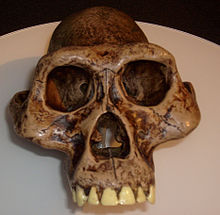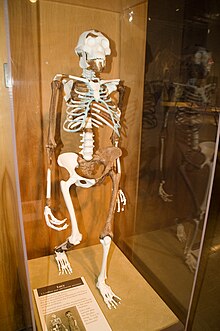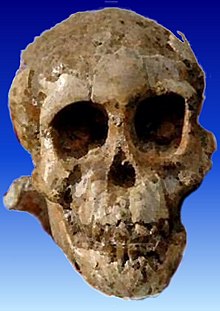Australopithecus afarensis
From Wikipedia, the free encyclopedia
| Australopithecus afarensis Temporal range: Pliocene | |
|---|---|
 | |
| Cast of the remains of "Lucy" | |
| Scientific classification | |
| Kingdom: | Animalia |
| Phylum: | Chordata |
| Class: | Mammalia |
| Order: | Primates |
| Family: | Hominidae |
| Subfamily: | Homininae |
| Genus: | Australopithecus |
| Species: | A. afarensis |
| Binomial name | |
| Australopithecus afarensis Johanson & White, 1978 | |
Contents[hide] |
[edit] Localities
Australopithecus afarensis fossils have only been discovered within northern Africa. Despite Laetoli being the type locality for A. afarensis, the most extensive remains assigned to this species are found in Hadar, Afar Region of Ethiopia, including the above-mentioned "Lucy" partial skeleton and the "First Family" found at the AL 333 locality. Other localities bearing A. afarensis remains include Omo, Maka, Fejej and Belohdelie in Ethiopia, and Koobi Fora and Lothagam in Kenya.[edit] Physical characteristics
[edit] Craniodental features and brain size

Australopithecus afarensis skull reconstruction, displayed at Museum of Man, San Diego, California
The image of a bipedal hominid with a small brain and primitive face was quite a revelation to the paleoanthropological world at the time. This was due to the earlier belief that an increase in brain size was the first major hominin adaptive shift. Before the discoveries of A. afarensis in the 1970s, it was widely thought that an increase in brain size preceded the shift to bipedal locomotion. This was mainly because the oldest known hominins at the time had relatively large brains (e.g. KNM-ER 1470, Homo rudolfensis, which was found just a few years before Lucy and had a cranial capacity of ~800 cm³).
There is considerable debate regarding the locomotor behaviour of A. afarensis. Some believe that A. afarensis was almost exclusively bipedal, while others believe that the creatures were partly arboreal. The anatomy of the hands, feet and shoulder joints in many ways favour the latter interpretation. The curvature of the finger and toe bones (Phalanges) approaches that of modern-day apes, and is most likely reflective of their ability to efficiently grasp branches and climb.
There are a number of traits in the A. afarensis skeleton which strongly reflect bipedalism, to the extent that some researchers have suggested that bipedality evolved long before A. afarensis.[4] In overall anatomy, the pelvis is far more human-like than ape-like. The iliac blades are short and wide, the sacrum is wide and positioned directly behind the hip joint, and there is clear evidence of a strong attachment for the knee extensors. While the pelvis is not wholly human-like (being markedly wide, or flared, with laterally orientated iliac blades), these features point to a structure that can be considered radically remodeled to accommodate a significant degree of bipedalism in the animals' locomotor repertoire. Importantly, the femur also angles in toward the knee from the hip. This trait would have allowed the foot to have fallen closer to the midline of the body, and is a strong indication of habitual bipedal locomotion. Along with humans, present day orangutans and spider monkeys possess this same feature. The feet also feature adducted big toes, making it difficult if not impossible to grasp branches with the hindlimbs. The loss of a grasping hindlimb also increases the risk of an infant being dropped or falling, as primates typically hold onto their mothers while the mother goes about her daily business. Without the second set of grasping limbs, the infant cannot maintain as strong a grip, and likely had to be held with help from the mother. The problem of holding the infant would be multiplied if the mother also had to climb trees. Bones of the foot (such as the calcaneus) also indicate bipedality.[5][6]
Computer simulations using dynamic modelling of the skeleton's inertial properties and kinematics have indicated that A. afarensis was able to walk in the same way modern humans walk, with a normal erect gait or with bent hips and knees, but could not walk in the same way as chimpanzees. The upright gait would have been much more efficient than the bent knee and hip walking, which would have taken twice as much energy.[7][8] It appears probable that A. afarensis was quite an efficient bipedal walker over short distances, and the spacing of the footprints at Laetoli indicates that they were walking at 1.0 m/s or above, which matches human small-town walking speeds.[9] Yet, this can be questioned, as finds of Australopithecus foot bones indicate that the Laetoli footprints may not have been made by Australopithecus.[10] Many scientists also doubt the suggestion of bipedalism, and argue that even if Australopithecus really did walk on two legs, it did not walk in the same way as a human.[11][12][13]
On the other hand, the presence of a wrist-locking mechanism might suggest that they engaged in knuckle-walking.[14] (However, these conclusions have been questioned on the basis of close analysis of knuckle-walking and the comparison of wrist bones in different species of primates).[15] The shoulder joint is also oriented more cranially (i.e. towards the skull) than in modern humans. Combined with the relatively long arms A. afarensis are thought to have had, this is thought by many to be reflective of a heightened ability to use the arm above the head in climbing behaviour. Furthermore, scans of the skulls reveal a canal and bony labyrinth morphology, which is not supportive to proper bipedal locomotion.[16]
It is commonly thought that upright bipedal walking evolved from knuckle-walking with bent legs, in the manner used by chimpanzees and gorillas to move around on the ground, but fossils such as Orrorin tugenensis indicate bipedalism around 5 to 8 million years ago, in the same general period when genetic studies suggest the lineage of chimpanzees and humans diverged. Modern apes and their fossil ancestors show skeletal adaptations to an upright posture used in tree climbing, and it has been proposed that upright, straight-legged walking originally evolved as an adaptation to tree-dwelling. Studies of modern orangutans in Sumatra have shown these apes using four legs when walking on large stable branches and when swinging underneath slightly smaller branches, but are bipedal and maintain their legs very straight when using multiple small flexible branches under 4 cm in diameter while also using their arms for balance and additional support. This enables them to get nearer to the edge of the tree canopy to grasp fruit or cross to another tree.
Climate changes around 11 to 10 million years ago affected forests in East and Central Africa, establishing periods where openings prevented travel through the tree canopy, and during these times ancestral hominids could have adapted the upright walking behaviour for ground travel, while the ancestors of gorillas and chimpanzees became more specialised in climbing vertical tree trunks or lianas with a bent hip and bent knee posture, ultimately leading them to use the related knuckle-walking posture for ground travel. This would lead to A. afarensis usage of upright bipedalism for ground travel, while still having arms well adapted for climbing smaller trees. However, chimpanzees and gorillas are the closest living relatives to humans, and share anatomical features including a fused wrist bone which may also suggest knuckle-walking by human ancestors.[17][18][19] Other studies suggest that an upright spine and a primarily vertical body plan in primates dates back to Morotopithecus bishopi in the Early Miocene of 21.6 million years ago.[20][21] the earliest humanlike primates. Known from fossil remains found in Africa, australopithecines, or australopiths, represent the group from which the ancestors of modern humans emerged. As generally used, the term australopithecines covers all early human fossils dated from about 7 million to 2.5 million years ago, and some of those dated from 2.5 million to 1.4 million years ago. The group became extinct after that time.[citation needed]
[edit] Social characteristics
It is difficult to reconstruct the social behaviour of extinct fossil species. However, the social structure is likely to be comparable to that of modern apes, given the average difference in body size between males and females (known as sexual dimorphism). Although there is considerable debate over how large the degree of sexual dimorphism was between males and females of A. afarensis, it is likely that males were relatively larger than females. If observations on the relationship between sexual dimorphism and social group structure from modern great apes are applied to A. afarensis then these creatures most likely lived in small family groups containing a single dominant male and a number of breeding females.[3](p239)For a long time, there were no known stone tools associated with A. afarensis, and paleoanthropologists commonly thought stone artifacts only dated back to approximately 2.5 million years ago.[22] However, a 2010 study published in Nature suggests the hominin species ate meat by carving animal carcasses with stone implements. This finding pushes back the earliest known use of stone tools among hominins to about 3.4 million years ago.[23]
[edit] Notable fossils
[edit] Type specimen
The type specimen for A. afarensis is LH 4, an adult mandible from the site of Laetoli, Tanzania.[24][edit] AL 129-1
Main article: AL 129-1
The first A. afarensis knee joint was discovered in November 1973 by Donald Johanson as part of a team involving Maurice Taieb, Yves Coppens and Tim White in the Middle Awash of Ethiopia's Afar Depression.[edit] AL 288-1 (Lucy)
Main article: Lucy (Australopithecus)
The first A. afarensis skeleton was discovered on November 24, 1974 near Hadar in Ethiopia by Tom Gray in the company of Donald Johanson, as part of a team involving Maurice Taieb, Yves Coppens and Tim White in the Middle Awash of Ethiopia's Afar Depression.[edit] AL 333
Main article: AL 333
In 1975, a year after the discovery of Lucy, Donald Johanson's team discovered another site in Hadar which included over 200 fossil specimens from at least 13 individuals, both adults and juveniles. This site, AL 333, is commonly referred to as the "First Family." The close alignment of the remains indicates that all the individuals died at the same time, a unique finding.[edit] AL 444-2
This is the cranium of a male found at Hadar in 1992.[25] By the time it was found, it was the first complete skull of Australopithecus afarensis.[26]The rarity of relatively complete craniofacial remains in the A. afarensis samples before the discovery of A.L. 444-2 seriously hampered prior meaningful analysis of those samples' evolutionary significance.
In light of A.L.444-2 and other new craniofacial remains, Kimbel, Rak and Johanson argue in favor of the taxonomic unity of A. afarensis.
[edit] Selam
Main article: Selam (Australopithecus)
In 2006 a dig in Dikika, Ethiopia, a few miles from the place where Lucy was found recovered the skeleton of a 3-year-old A. afarensis girl which comprised almost the entire skull and torso, and most parts of the limbs. The features of the skeleton suggested adaptation to walking upright (bipedalism) as well as tree-climbing, features that match the skeletal features of Lucy and fall midway between human and humanoid ape anatomy. "Baby Lucy" has officially been named "Selam" (meaning peace in the Amharic/Ethiopian Language).[27][edit] 2011 Hadar finding
In February 2011, the discovery of a 3.2 million year-old bone in Hadar, Ethiopia at the AL 333 site was announced.[28] The foot bone shows that the species had arches in its feet, which confirmed that the species walked upright for the majority of the time.[29] The foot bone is one of 49 new bones discovered, and indicates that A. afarensis is "a lot more human-like than we had ever supposed before", according to the lead scientist on the study.[30][edit] Others
[edit] Related work
Further findings at Afar, including the many hominin bones in site 333, produced more bones of concurrent date, and led to Johanson and White's eventual argument that the Koobi Fora hominins were concurrent with the Afar hominins. In other words, Lucy was not unique in evolving bipedalism and a flat face.Recently, an entirely new species has been discovered, called Kenyanthropus platyops, however the cranium KNM WT 40000 has a much distorted matrix making it hard to distinguish (however a flat face is present). This had many of the same characteristics as Lucy, but is possibly an entirely different genus.
Another species, called Ardipithecus ramidus, was found by White and colleagues in the 1990s. This was fully bipedal, yet appears to have been contemporaneous with a woodland environment. Scientists have a rough estimation of the cranial capacity of Ar. ramidus at 300 to 350 cm³, from the data released on the Ardipithecus specimen nicknamed Ardi in 2009.[31]






No comments:
Post a Comment